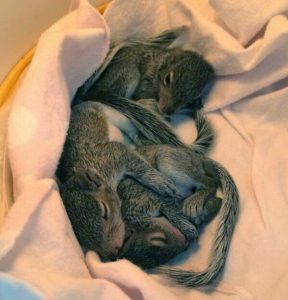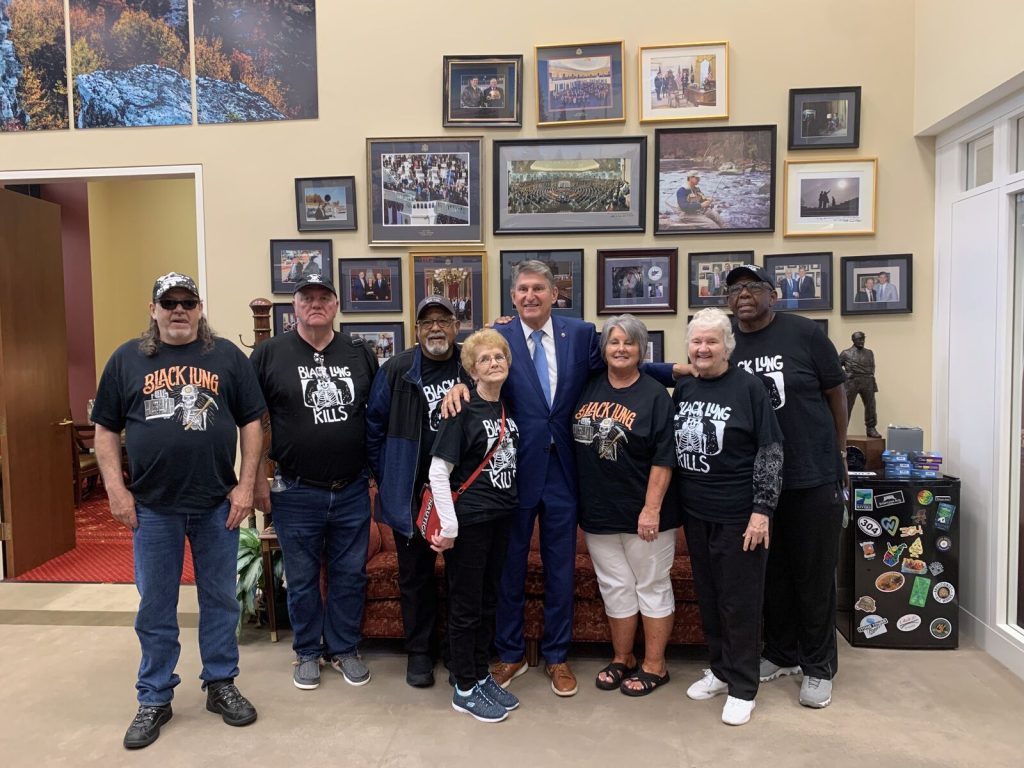Born to be Wild
Wildlife rehabilitation in Appalachia
By Lorelei Goff

After their nest was destroyed, Carlton Burke built these baby barn owls a makeshift home out of a plastic garbage can. The parent birds soon returned to care for their owlets. Photo by Carlton S. Burke, Carolina Mountain Naturalists
A snapping turtle lays in the road, unborn eggs shielded inside her shattered body. A possum gives birth inside a suburban attic. A starving snowy owl wanders far outside its natural range and develops a crippling illness. A mother mallard hatches her ducklings outside a grocery store and tries to lead them across a busy highway.
Though each of these stories ended happily, thanks to wildlife rehabilitators across the region, humanity’s rapid encroachment on wild places is taking a heavy toll.
“Ninety percent of the animals come in because of human involvement,” says Jessie Cole, a wildlife rehabilitator at Rockfish Wildlife Sanctuary in Nelson County, Va. “Humans are leaving an imprint on the earth and, unfortunately, animals sometimes have to pay the consequences for that.”

Animal rehabilitators care for a diverse range of animals, including these three infant squirrels. Photo courtesy of Kentucky Wildlife Center, Inc.
Animals that become accustomed to feeding on human food or trash are often injured or sickened and they can never be re-wilded.
Dana Dodd, president of the Appalachian Bear Rescue in Townsend, Tenn., says, “Last summer, [Tennessee Wildlife Resources Agency] had to put down a mother bear and four cubs because they had made their living eating trash in Gatlinburg. It’s not the wildlife officers who kill those animals. It’s the people who cause the situation.”
Walking on the Wild Side
Rehabilitators face daunting challenges, including the cost. They operate without state or federal funding, relying on donations to cover expensive veterinary care, antibiotics, fluid therapy, milk replacer and other supplies.
Be a Good Neighbor
Humans can minimize the negative impact we have on our wild neighbors. Make food sources — like pet food, birdseed and trash — inaccessible and keep barbecue grills clean.
Think twice before throwing food scraps along roadsides where animals and birds can be injured or killed by traffic. Don’t place sticky traps where hungry birds can get caught in them, and hang something in large picture windows so birds know they’re there. Open containers of liquid are also dangerous and can drown chipmunks, bats and other small animals.
“Each species has to have its own species-specific milk replacer that’s been manufactured in the lab to closely resemble the mother’s milk,” says Jennifer Crabill, director of the Kentucky Wildlife Center in Lexington. “One 20-pound tub of raccoon milk replacer runs roughly $200. We go through that in about a week.”
Finding volunteers is another obstacle.“It’s very different from volunteering at a humane society where you’re walking dogs and playing with cats and it’s very fun,” Crabill warns.
“Volunteering with a rehabilitation center is very hard work. You get dirty. They’re wild animals so they’re unpredictable and there’s a chance that you’re going to get scratched or bit.”
According to Crabill, relying on volunteers can create its own issues. “Sometimes they decide that they have something else that they would rather do and we end up being short staffed,” she says.
Carlton Burke, a home-based wildlife rehabilitator and freelance naturalist, says tough decisions and a heavy workload also take a toll. “Sometimes you have an animal so severely injured that the animal has to be euthanized,” he says. “Possibly 50 percent or more might not be able to ever go back out to the wild. That’s just the reality of wildlife rehabilitation.

This young raccoon has a condition called leucism that affects its coloring. Photo courtesy of Kentucky Wildlife Center, Inc.
“A lot of wildlife rehabilitators get burned out,” Burke continues. “It’s very frustrating because of all the calls you get and you just can’t take care of them all. We need more rehabilitators and facilities to spread the work around a little better.”
When Love Hurts
Another frustration for rehabilitators is that many calls they receive are for orphaned birds and animals that are mistakenly kidnapped by well-intentioned humans.
“This is very common with rabbits and deer,” says Crabill. “In the wild, mother rabbits and mother deer have a very strong scent that attracts predators. The babies have no scent whatsoever. The mother only comes back to feed the babies and stays away the rest of the time so as not to attract a predator.”

These red fox kits will remain at the rehabilitation center until they are five to six months old and can be released into the wild. Photo courtesy of Rockfish Wildlife Sanctuary
According to Crabill, trying to raise an orphaned bird or animal, which is illegal in most states without the proper permits for rehabilitation or education, is a bad idea. Each species must maintain a specific body temperature and requires special milk and foods. If fed improperly or with the wrong kind of nipple, the babies can develop pneumonia or even drown.
Sometimes rescued animals need intravenous fluids and antibiotics.
Even if an orphan survives, making a pet out of wildlife and later abandoning it when it becomes too difficult to handle is essentially giving that animal a death sentence.

In periods of heavy rains, young waterfowl — such as this Canada Goose gosling — can be separated from their family. Photo courtesy of Rockfish Wildlife Sanctuary
“It would be like taking an 8- or 10-year-old child out of their home, driving them to the middle of New York City, [and] dropping them off,” says Cabrill.
An animal is considered unreleasable once it bonds with humans and depends on them for food. Jesse Cole of Rockfish Wildlife Sanctuary tells a story of a raccoon named Bob that was kept as a pet for 10 years. Often, such an unreleasable animal would be euthanized, but Bob was lucky. The sanctuary had a space for an educational animal available.
“When Bob arrived, he was about three times the size of a normal raccoon. He was fed a diet of chicken McNuggets and marshmallows, just candy and junk food,” says Cole. “So he came to us extremely obese. His hair was falling out because of his improper diet. He was depressed.”
Bob is slowly beginning to make progress after two months at the sanctuary, but Cole doesn’t know if Bob will ever be able to bond with another raccoon, even in captivity.
If You Love Somebody, Set Them Free
Rehabilitators do what they do so animals can remain free and fill their place in the web of life. While every rehabilitator cherishes a successful release, their favorite success stories are the ones that keep the animals in the wild in the first place.
State Directories:
Tennessee
Virginia
Kentucky
North Carolina
Websites:
Tennessee
Appalachian Bear Rescue
Wynn Wood Wildlife Rehabilitation Center
The Elephant Sanctuary
Tiger Haven
Kentucky
Kentucky Wildlife Center
Appalachian Wildlife Refuge
Virginia
Rock Fish Wildlife Sanctuary
The Wildlife Center of Virginia
Blue Ridge Wildlife Center
North Carolina
On a hot, June day in 2015, Carlton Burke received a call about baby barn owls. A tree-trimming company had been hired to cut back an old silver maple at the Pines Country Inn near Brevard, N.C. A nest containing the babies was thrown from a large, hollow limb as it crashed to the ground. Two owlets were crushed under the limb and the rest were rushed to a veterinarian’s office. Burke arrived, greeted by the incredibly loud hissing of the terrified babies, and was saddened to realize that a couple more of them would have to be euthanized because of their injuries.
“I was determined to try to save the remaining two and get them back to the parents if at all possible,” says Burke.
Instead of taking them into captivity, hand-raising them and then trying to teach them to hunt and release them back into the wild, Burke devised a makeshift nest out of a large plastic trash can, put it back in the same tree and placed the fuzzy, hissing owlets inside. The parents came back and took care of them even though it wasn’t the original nest.
Burke observed the baby owls’ progress with trail cameras. Several weeks later the two fledged and flew off to take their places in the wild.
“It’s pretty gratifying to know that you stepped in and did something, and what you thought would work, actually did work,” he says.
Related Articles
Latest News

Leave a comment
Your email address will not be published. Required fields are marked *




